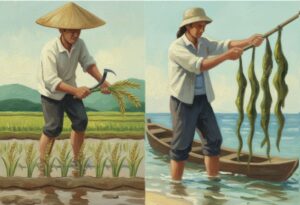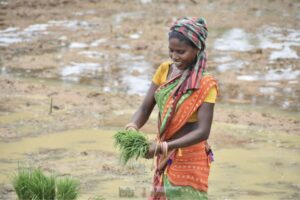
Just south of Vietnam’s largest city, Ho Chi Minh City, the great Mekong River meets the South China Sea, forming a delta so rich it has become Vietnam’s “rice bowl.” It includes 12 rice-growing provinces that produce about half of the country’s rice.
After the Pacific War that resulted in famine in 1945, and the Vietnam War that saw its last gunfire in 1975, Vietnam sought to rebuild itself—and rice production has been a part of this. In 1968, the International Rice Research Institute released rice variety IR8 (dubbed “miracle rice”) to the northern and southern rice-growing regions of Vietnam, but this was not enough for the nation to become self-sufficient in rice.
Things changed, however, when, in 1986, Vietnam adopted the “Doi Moi” policy that sought to reform the economic system into a market-driven economy. The Vietnamese government effectively told its rice farmers to “grow and sell” their rice. This decision allowed Vietnamese rice growers to start adopting the improved varieties and management techniques of the Green Revolution that had vastly improved rice production in other nations about 20 years earlier.
Soon after, Vietnam finally became rice self-sufficient and went on to increase its rice production year after year, over a period of more than 20 years. This sustained growth allowed the country to export rice to Asia, Africa, the Middle East, the Americas, and Europe.

In 2008, according to the Food and Agriculture Organization of the United Nations, Vietnam produced almost 39 million tons of rice on 7.4 million hectares, making it the fifth-largest rice producer and the second-largest rice exporter in the world.
Since 1963, IRRI and Vietnam have been partners in a wide range of collaboration in the exchange of rice breeding materials, rice varietal improvement, resource management, and capacity building.
In 1978, 3 years after Vietnam and IRRI formally established ties, IRRI Director General Nyle Brady signed a memorandum of agreement with Vietnam, which laid the foundation for decades of collaboration. This partnership was strengthened with the establishment of the IRRI-Vietnam office in 1992, as well as visits of Vietnamese government officials to IRRI, including President Le Duc Anh’s trip in 1995.
As farmers in the Mekong River and Red River deltas enjoy the potential of high-yielding varieties, which were made available to them through these joint projects, Vietnam further expanded its scope of collaboration with IRRI to include rice production in upland ecosystems, protecting the environment, and improving grain quality (see Leaving poverty behind in marginal uplands).
IRRI’s partnerships and work with Vietnam were recognized in 1994 with the First Class Friendship Order that the Vietnamese government awarded IRRI.
Notably, IRRI’s collaboration with Vietnam includes more than a dozen projects and the training of hundreds of Vietnamese scientists. The cooperation continues today, as Vietnam’s Ministry of Agriculture and Rural Development gears up to host IRRI’s 3rd International Rice Congress that will be held in Hanoi on 8-12 November 2010.
__________________________________
Ms. Baroña is a science communication specialist with IRRI’s Communication Unit.









